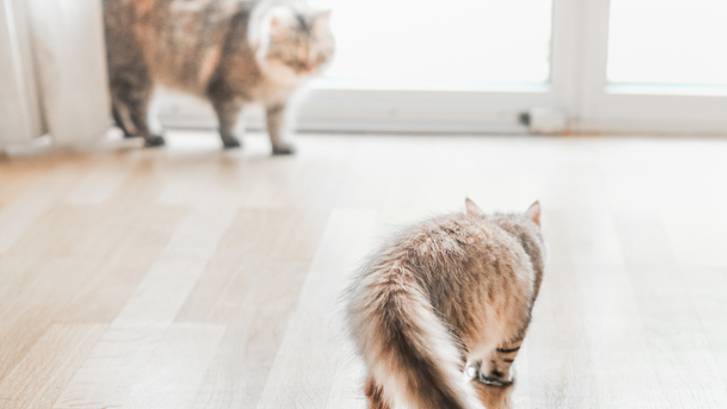Are my cats playing or fighting? How to tell the difference
It’s not always obvious whether your cats are playing or fighting - learn to spot the difference to keep things friendly

If you’ve got more than one feline friend, then it's more than likely you'll begin to question 'are my cats playing or fighting?' at some point.
Though cats are playful pets who love to engage in activity that stimulates their hunting instincts, there may be times where you question whether that seemingly rough play is actually genuine dislike between your pets. Is it normal for cats to play with each other in the form of fighting? How do you spot the difference between play or fighting and what should you do if friendly play turns into something less agreeable?
While it’s fine for cats to play with each other, if play fighting escalates into real fighting this can cause problems, from a unharmonious household to actual injuries inflicted on one or more of your cats.
Learning to recognize when your cats are just playing, or you need to intervene, is a valuable part of pet parenthood - so read on to find out more.
- Best cat toys: Boredom-busting playthings for your feline
- How to play with a cat: A vet's guide to keeping your cat entertained
- Why does my cat bring me toys and other gifts?
How do cats play with each other?
By their very nature, cats are playful creatures, and usually when there’s more than one in the household, they will play together quite happily most of the time.
Most cats will employ tactics that can look like fighting for their play, such as stalking, chasing, kicking, biting, scratching, ambushing, and even straightforward attacking. They may also play with and fight over their favorite toys. However, what generally marks it out as playful rather than aggressive is that it is reciprocal between the cats, with each taking it in turn to be the more dominant one.
Cats who frequently play together are usually well-bonded, and you shouldn’t be too worried if they spend a lot of time playing together - so long as it stays on the right side of fun.
Get the best advice, tips and top tech for your beloved Pets

How do you tell the difference between cats play and fight?
Your cats can be playing together quite happily, when all of a sudden things turn a little bit nasty. Getting to know your cats behavior and the way they act will help you to become finely attuned to those pinch points that can cause a flare up.
Paying close attention to the body language of your cats will usually give away a few tell-tale clues. Look out for the following:
- Ears When cats are relaxed and happy, their ears will generally be in a standard upright position. When they are worried, tense or on the offensive, then you might notice that they seem to be pinned back.
- Claws Generally, when cats are only playing they won’t have their claws extended. Watch out for the claws coming out - especially as these can cause damage to the other cat and their surroundings.
- Body position Usually when cats are simply playing with each other, their bodies will be positioned forwards, but if you notice them starting to lean back on their back legs while they claw at each other, this can be a sign of deeper aggression.
- Fur Pay attention to your kitty’s fur and how it stands up. Cats do this to make themselves appear bigger and more aggressive - so you won’t usually see it when cats are simply play-fighting with each other.
- Biting Biting may look worse than it is, as most of the time little nips and bites are all part of the fun. But if one cat really sinks their teeth into the other, you’ll usually be able to tell something more serious is going on.
- Speed Cats who are playing with each other tend to do it in a steady, fairly calm manner. If the fighting ramps up and is frantic, it could be a sign that things are getting a little out of hand.

How do you tell if cats are getting along?
You want your cats to play together as it’s a sign that they’re getting along and are happy to be living together. It’s also great if they eat and sleep together to form a really close bond.
It’s usually quite easy to tell if cats are happy to be in each other’s company - play fighting stays just as that. You’ll notice that each of your cats takes it turn to play, to be the dominant force, and to be the one dishing out the bites, scratches and so on.
You’ll find that they chase each other, rather than one cat chasing the other one or trying to be too dominant over the other.
If your cats do end up having a more serious fight, this isn’t necessarily something to be overly concerned about. Pay attention to how they behave directly after the fight - if they go back to a normal, loving relationship, then it might just be a simple flare up caused by something quite easy to resolve. If it’s happening quite often, you might need to think about removing stress points, or perhaps even discussing with your vet to check that there’s not a deeper problem.
Do cats bite each other when they play?
Cats, like many animals, use their mouths to navigate the world. That means that cat play biting can be a normal part of play fighting and shouldn’t be something to worry about if you see it happen. You should generally find that your cats will take it in turns to bite each other too, which will show that they’re playing and not being too aggressive.
You’ll usually know if it’s turned into a problematic or painful bite, as the cat on the receiving end will give out a yelp or a howl if it’s gone too far. Should that happen, take a look for any broken skin so you can be on top of any potential infections. Remember to always seek advice from your vet if you’re particularly worried.

How to help cats get along
Most of the time, your cats will be happy and harmonious, but it can take some time to get to that point, especially when you introduce a new cat for the first time. It’s important to have an approach which not only breaks up fights as when they happen, but also ideally stops them from happening in the first place.
Ensure they have their own space
A common reason for fights is simply territorial. Make sure your cats each have their own space, including their own food bowl, their own litter tray, their own bed and even their own toys to play with. Basically, your cats are like toddlers and most don’t like sharing.
Break up the fighting
Should a fight occur, knowing how to quickly stop it will send the message that it won’t be tolerated. Often the best way to stop a cat fight is through distraction - such as a loud bang (try banging a pot or a cupboard door). If that doesn’t work, try to separate your cats as gently as possible - using something like a board or a cushion to place between them is the best approach - using your hand is to be avoided as it can wind up with injury to yourself.
Keep your cats separated
After a fight has happened, keep your cats separated for a little while, reintroducing them to each other gently and guardedly. Some even choose to put them on either side of a baby gate so they can say “hello” to each other without being able to get too physically close.
Read next: how do cats play with each other?
Amy Davies is a freelance writer and photographer with over 15 years experience. She has a degree in journalism from Cardiff University and has written about a huge variety of topics over the years. These days she mostly specialises in technology and pets, writing across a number of different titles including TechRadar, Stuff, Expert Reviews, T3, Digital Camera World, and of course PetsRadar. She lives in Cardiff with her dog, Lola, a rescue miniature dachshund.

